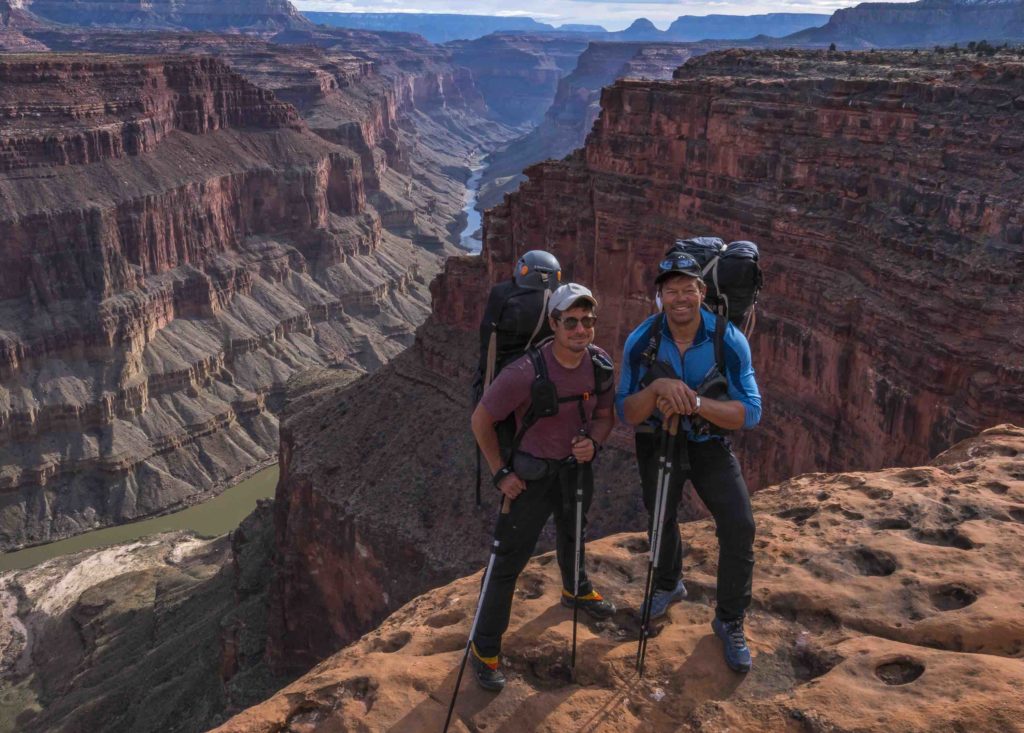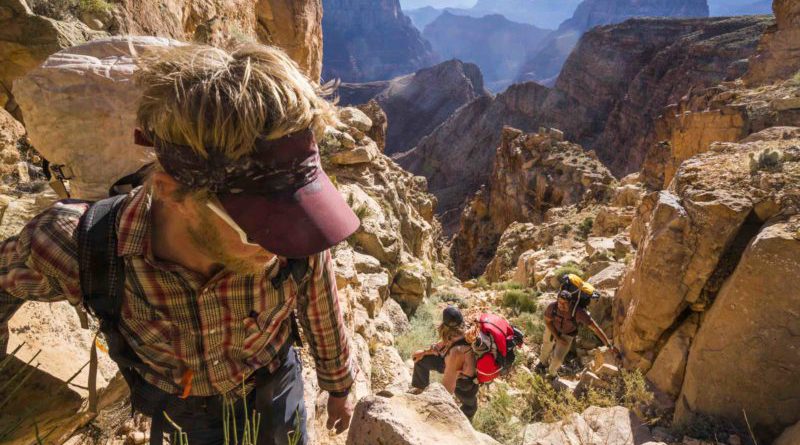INTERVIEW: Pete McBride goes ‘Into the Grand Canyon’ on Nat Geo
Photo: Ascending the Walter Powell “Trail” — a historic and rarely used route out of the Canyon — Mathieu Brown shows salt and exhaustion on his brow. Kevin Fedarko and Kelly McGrath follow on his heels during an end-to-end canyon hike, to highlight the secret and fragile beauty between the rim and the river. Photo courtesy of Pete McBride / Provided by Nat Geo with permission.
World-respected photographer Pete McBride knows a thing or two about the Colorado River. The serpent-like waterway, which snakes its way from Colorado to Mexico, has inspired him since he was a child, and professionally he has documented the twists and turns of the river in his photographs, his lectures and even a book.
His latest project, now streaming on National Geographic, is called Into the Grand Canyon, and it looks at perhaps the most famous stretch of the Colorado River, where the water plays architect and cuts the rocks of the Grand Canyon.
A couple of years ago, McBride and journalist Kevin Fedarko embarked on a 750-mile journey into the Grand Canyon, using the river as their guide. What they captured is thrilling, adventurous and eye-opening.
“I actually did a book project and some short films on the Colorado River, and I was invited to the Grand Canyon to do a talk about the Colorado River, which is, of course, the architect of the canyon,” McBride said in a recent phone interview. “And when I was there, I just started hearing everyone discussing the future of Grand Canyon and a lot of development pressures. It was at that point that I said, huh, maybe I should actually take a look at this place, because I actually thought the place was one of the most protected pieces of landscape on the planet as most people do because it’s a national park. And I was surprised to learn that there was potential for it to change.”
At about the same time, McBride was reading The Man Who Walked Through Time: The Story of the First Trip Afoot Through the Grand Canyon by Colin Fletcher. Here was an adventurer who walked through the park in the 1960s, and McBride wanted to honor that trip with his own. It just so happened that McBride’s efforts coincided with the 100th anniversary of Grand Canyon National Park.
“Little did I know a) how hard it would be and b) how long it would take,” he said. “Eighty-some percent of it there’s no trail, so you have to find your way through it. So it’s very unexpected. You start to know a little bit about which rock layer to walk on and what to predict. There’s no cell service. There’s no electricity. Satellite communications are even challenged, so you don’t have modern technology in there. You’re truly in wilderness, relying on natural systems. We actually followed sheep poop and lion tracks for much of it as a way to figure out what’s the best way through because you can easily get pinned on 500-foot cliffs, so you’re trying to avoid that, of course.”
McBride and Fedarko couldn’t walk by the river itself because the terrain was too vertical. Most of their travails were above the river, approximately 3,000 feet below the rim.
“Finding water became a huge challenge, and the film shows that to a degree,” he said. “It was a daily adventure.”
The journey was stressful, but McBride was quick to point out that it was a wonderful experience, especially because he had his friend by his side. The photographer predicted that the journey would not have been successful without their bond.
“At the end of the day, it’s a story of our most iconic national park, but it’s also a story of friendship,” he said. “I think we carried each other through to a degree, with humor as well. To laugh in the face of adversity and physical, psychological challenges was incredibly helpful.”

McBride grew up in Colorado and loved playing outdoors and in the surrounding mountains. He eventually secured a job with National Geographic and worked for the magazine for 10 years. He would travel to some of the remotest areas of the globe, but it was when he was assigned a story on the Colorado River that his inspiration shifted.
“I think it just really hit me that it seemed like such an important story that’s not being told,” he said of the project. “That led to the Grand Canyon, and then Grand Canyon, once you’ve spent time there, it has the ability to get into your blood a little bit. It’s such a powerful landscape that it kind of captivates you. As I’ve gotten older, I like trying to tell stories closer to my greater home, being the Southwest.”
For Into the Grand Canyon, McBride was forced to travel light. To capture the photographs and video clips, a lot of equipment was needed, but the idea of carrying around pounds and pounds of extra cameras didn’t seem like a smart idea.
“I started out trying to carry a usual amount of equipment for film production and magazine photography, and that was just too much,” McBride said. “It nearly killed me literally, so, yes, it became hard. And it was a constant psychological stress as well — trying to survive, move, stay alive and then make sure your camera systems or batteries are working in a place where there’s nowhere to charge anything. But the technology today is pretty remarkable. I shot the entire film predominantly on one camera and one lens, a little Sony mirrorless camera. You couldn’t have done that 20 years ago, so that does help. But at a bare minimum, I was still carrying an extra 15 pounds of equipment on top of all my other stuff — food, water, climbing gear, camping gear. It made for a heavy pack.”
The film, which has premiered on the network and is still available to stream, has inspired viewers to take a second look at this iconic national park and the outdoors in general. For McBride, this exploration on the part of the TV viewer is exactly what he wants.
“Don’t forget that national parks, we’re lucky to have them,” he said. “They’re an amazing place to reconnect with our natural world, which I think we’re losing connection with, with our addiction to screens. Don’t take them for granted. It takes each generation to remember that and step up and decide how we want to move these national parks forward. Do we want to keep them as they are, which was the original intent, or do people really want to shift them and change them into something more toward amusement. I hope it reminds them that keeping them wild is an important and valuable asset for the future.”
By John Soltes / Publisher / John@HollywoodSoapbox.com
Into the Grand Canyon, featuring Pete McBride and Kevin Fedarko, is now available to stream on National Geographic. Click here for more information.

